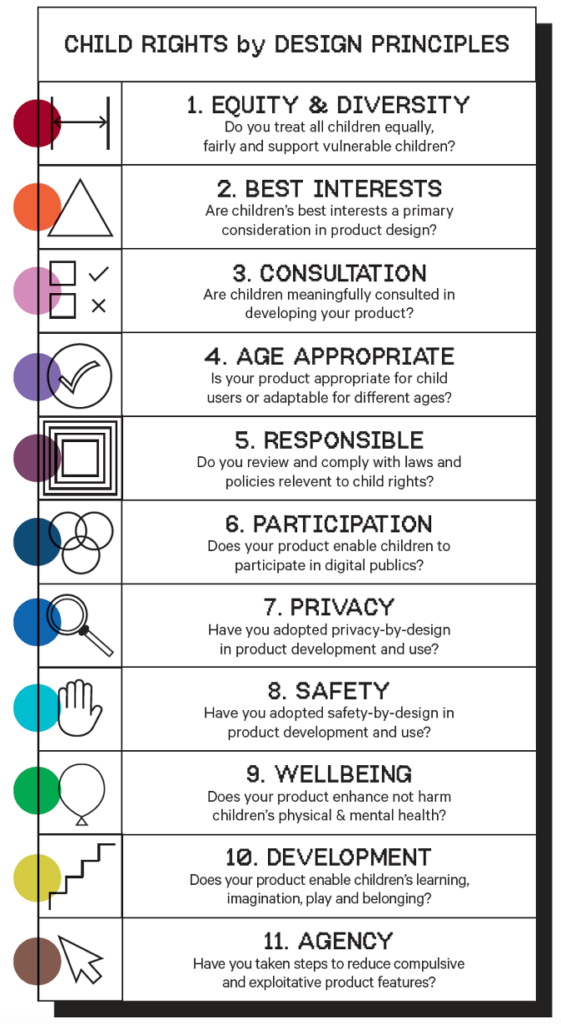by Sonia Livingstone and Kruakae Pothong
Child Rights by Design is a principled vision to inspire innovators to help realise children’s rights when designing digital products and services. It is grounded in the United Nations Convention on the Rights of the Child (UNCRC), the most widely ratified international human rights treaty ever, applicable to all children from birth to 18 years old, and holistic, balanced, authoritative. Its implementation in relation to the digital environment is set out in the Committee on the Rights of the Child’s General Comment No. 25.
So in the Digital Futures Commission, we asked ourselves, how can we translate the UNCRC and General Comment No. 25 into a tool that’s practical for designers and developers, to answer the question, what does good look like when designing with children in mind?

In the guidance just launched, we explain the 11 Child Rights by Design principles and match them with practical advice for innovators – designers, developers and others, including CEOs. Please put the principles on your office wall, bookmark it in your tabs, or pin it to your design boards.
Why we developed Child Rights by Design
Digital technologies are part of the infrastructure of children’s daily lives – they are no longer optional for children but, indeed, crucial to their development and prospects. Yet digital spaces are proprietary, and business models are based on wide and deep data collection to monetise attention and identities. And yet too often, children remain invisible in the digital world (despite being one in three internet users worldwide). With the coming of the metaverse, it is ever more vital to find multistakeholder approaches to innovation that embed children’s needs and rights from the outset.
Our Guidance for Innovators work stream has been exploring ways to make a change. The task was to identify and demonstrate what good looks like for children in a digital world, recognising children’s evolving capacities (from birth to 18) and their diverse circumstances. We decided to build on “by design” approaches being developed across public, private and third sectors. While these are promising, and important, innovators and policymakers pay most attention to the ‘hygiene’ factors of safety and security, sometimes privacy, often neglecting children’s positive rights or the crucial balance needed between different risks, opportunities and rights.
How we developed Child Rights by Design
We worked collaboratively with people of many kinds of expertise and experience – that includes consulting children and young people – always the best part! You’ll find lots of what they said in our report. We sought to find ways to shape the digital environment differently and better – in children’s best interests – by drawing on the combined wisdom of about 100 relevant policy documents, national and international.
After reflecting on lessons learned from our two use cases – Playful by Design and Beneficial Uses of Education Data, to cut a long story short, we mapped all the articles of the UNCRC, and all the provisions of General Comment No.25, and distilled 11 design principles.
We tried to make our task practical by focusing on the UK (though we hope the work has wider value). And we tried to make it transparent through webinars, discussions, and blogging the progress of our work throughout. Working again with designers and developers, we mapped the principles onto the Design Council’s Double Diamond – we have one of these for each principle, highlighting ‘stop and think’ questions for each phase of Discover (to get insight into the problem), Define (to decide what to build), Develop (to try potential solutions) and Deliver (to identify solutions that work).
We searched out design resources for each principle too, to make the toolkit really practical. And we conclude with a checklist – how to keep all the principles in mind, figure out the steps to take, and identify your to-do list!
Who is Child Rights by Design for?
Any and all innovators of digital products and services used by or likely to impact on children:
- By innovators, we include designers, developers, product managers, executives, marketers, UX (user experience) researchers and professionals in the legal, policy or planning departments of start-ups, mid-sized companies and major corporates, as well as those working on standards, compliance and procurement in the public, private or third sector. A ‘by design’ approach must engage the whole organisation, from the CEO onwards, although we especially have designers in mind.
- We include digital products and services intended for children and the many products and services that children use – perhaps unnoticed – as part of a broader market. We also include products and services that children don’t use directly but that impact them (cameras in public places, school information management systems, health databases or parental control tools). This includes a host of products and services across the value chain that need to start thinking about children.
We acknowledge that designing for child rights isn’t easy. But retrofitting design to respect rights after a product is developed can be difficult, and expensive. As we say in the report, Child Rights by Design shouldn’t be seen as a tick-box exercise but an exciting road map. For although we don’t promise all the answers, we are confident of the direction of travel.
We hope you agree with us that, taken together, these 11 principles indeed answer the question of what good looks like!